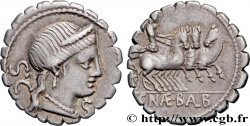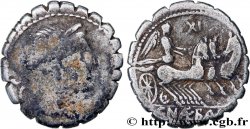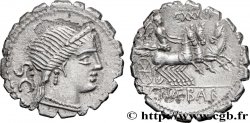v38_0416 - NAEVIA Denier serratus
MONNAIES 38 (2009)
Prezzo di inizio : 175.00 €
Valutazione : 250.00 €
Prezzo realizzato : 242.00 €
Numero di offerte : 3
Offerta maxima : 242.00 €
Prezzo di inizio : 175.00 €
Valutazione : 250.00 €
Prezzo realizzato : 242.00 €
Numero di offerte : 3
Offerta maxima : 242.00 €
Tipo : Denier serratus
Data: 79 AC.
Nome della officina / città: Rome ou Italie
Metallo : argento
Titolo in millesimi : 950 ‰
Diametro : 19,5 mm
Asse di coniazione : 6 h.
Peso : 3,96 g.
Commenti sullo stato di conservazione:
Exemplaire sur un flan large et bien centré des deux côtés avec les grènetis visibles des deux côtés. Très beau portrait. Joli revers. Très belle patine de collection ancienne gris foncé avec des reflets dorés
N° nelle opere di riferimento :
Pedigree :
Cet exemplaire provient de MONNAIES XXIII, n° 247 où il s’est vendu 193€ avec quatre offres
Diritto
Titolatura diritto : S. C.
Descrittivo diritto : Tête diadémée de Vénus à droite.
Traduzione diritto : “Senatus Consulto”, (avec l’accord du Sénat).
Rovescio
Titolatura rovescio : CNÆ B(AL)B.
Descrittivo rovescio : Victoria (la Victoire) dans un trige galopant à droite, tenant les rênes des deux mains ; au-dessus, marque de contrôle XXXVI (36).
Traduzione rovescio : “Cnæus Nævius Balbus”, (Cneius Naevius Balbus).
Commento
Poids lourd. Pour ce type, M. Crawford a relevé une estimation de 280 coins de droit et de 311 coins de revers. La représentation du trige est aussi rare dans les numismatiques gauloise que romaine. On trouve dans l'ouvrage de LA TOUR (LT. 10074, 10075 et 10085), les dessins de trois deniers copiés ou imités sur ce prototype par les Celtes du Danube.
Heavyweight. For this type, Mr. Crawford noted an estimate of 280 obverse dies and 311 reverse dies. The representation of the trige is as rare in Gallic as in Roman numismatics. We find in the work of LA TOUR (LT. 10074, 10075 and 10085), the designs of three denarii copied or imitated on this prototype by the Celts of the Danube
Heavyweight. For this type, Mr. Crawford noted an estimate of 280 obverse dies and 311 reverse dies. The representation of the trige is as rare in Gallic as in Roman numismatics. We find in the work of LA TOUR (LT. 10074, 10075 and 10085), the designs of three denarii copied or imitated on this prototype by the Celts of the Danube








 Segnalare un errore
Segnalare un errore Stampate la pagina
Stampate la pagina Condividi mia selezione
Condividi mia selezione Fai una domanda
Fai una domanda Consegnare / vendere
Consegnare / vendere
 Descrittivo
Descrittivo















